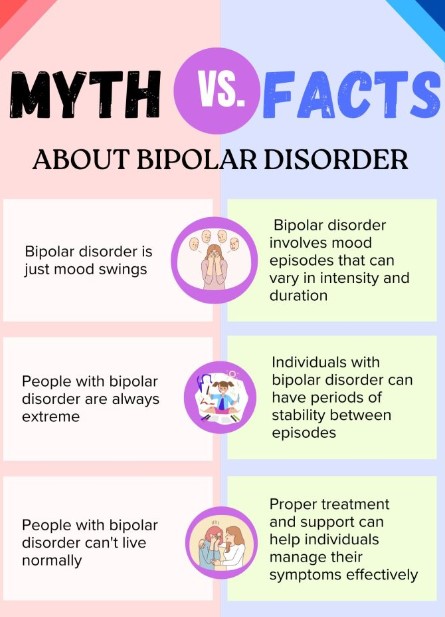BOURSESSENEGAL – Bipolar disorder significantly influences how a person thinks, feels, and behaves. This condition is more than just mood swings; it shapes an individual’s perception of reality. In this post, we will explore the intricacies of how a person with bipolar thinks, delve into their emotional landscape, and provide insights that can foster empathy and understanding. By the end, you’ll gain a deeper appreciation of the bipolar experience and how to support those affected.
What Is Bipolar Disorder?
Bipolar disorder, formerly known as manic depression, involves extreme mood fluctuations. These shifts include emotional highs (mania or hypomania) and lows (depression). Understanding how a person with bipolar thinks begins with recognizing these cycles. Each phase can dramatically alter their thoughts, leading to varied perceptions and behaviors.
The Different Phases of Bipolar Disorder
- Manic Phase: During mania, a person may feel euphoric, highly energetic, or unusually irritable. Their thoughts race, and they often experience an inflated sense of self-esteem. This period can lead to impulsive decisions without considering the consequences. A person might engage in risky behaviors, like spending sprees or reckless driving.
- Hypomanic Phase: Hypomania is less severe than full-blown mania. Here, the person may still feel energetic and confident but can maintain a level of control over their actions. Although it might feel productive, it can still disrupt relationships and daily activities.
- Depressive Phase: In contrast, the depressive phase brings overwhelming feelings of sadness, hopelessness, and lethargy. During this time, a person may struggle to concentrate and might have negative thoughts about themselves or their future. This phase often feels like a heavy fog that clouds their mind.
- Mixed Episodes: Sometimes, symptoms of mania and depression can occur simultaneously. This combination can be particularly confusing and distressing. A person might feel agitated while also experiencing deep sadness.
How Do Thoughts Change During Each Phase?
The way a person with bipolar thinks varies dramatically across these phases. Let’s explore these shifts in more detail.
Thinking Patterns in the Manic Phase
During mania, thoughts race at lightning speed. This can lead to an overwhelming flood of ideas. Here’s what you might notice:
- Increased Creativity: Many individuals report heightened creativity during manic episodes. They may come up with innovative solutions or engage in artistic endeavors.
- Grandiosity: Thoughts often center around inflated self-esteem. A person might believe they can accomplish anything or that they possess unique talents.
- Distractedness: While they may feel more productive, their focus can be scattered. One idea quickly leads to another, making it hard to finish tasks.
Thinking Patterns in the Depressive Phase
Contrastingly, depressive phases bring a stark shift in thought patterns:
- Negative Self-Talk: A person may struggle with feelings of worthlessness. Thoughts can be harsh and self-critical, leading to an overwhelming sense of despair.
- Cognitive Distortions: Individuals often experience distorted thinking, where they view situations through a negative lens. They might see themselves as failures, ignoring their accomplishments.
- Difficulty Concentrating: Many people find it hard to focus on even simple tasks. This can exacerbate feelings of inadequacy.
The Impact of Mixed Episodes on Thinking
Mixed episodes can create a unique cognitive turmoil. Individuals might feel restless yet hopeless. They may find it challenging to process their emotions and thoughts effectively. Understanding how a person with bipolar thinks during these times is crucial for providing support.
How External Factors Influence Thoughts
Stress and Environment
Stressful situations can trigger episodes. Environmental factors like work pressures, relationship issues, or major life changes can exacerbate symptoms. The context in which a person with bipolar thinks plays a critical role in how they manage their condition.
Relationships and Social Interactions
Social dynamics also affect thought patterns. During manic phases, individuals might seek out social interactions, enjoying the heightened sense of energy. Conversely, during depressive episodes, they may withdraw from friends and family, feeling disconnected.
Medication and Treatment Effects
Treatment options, including medication and therapy, significantly influence thinking. Proper management can stabilize moods, helping individuals regain a clearer thought process. Regular therapy can also provide tools for coping with negative thought patterns.
How to Support Someone with Bipolar Disorder
Understanding how a person with bipolar thinks is the first step toward offering effective support. Here are some practical tips:
Listen Without Judgment
One of the most valuable things you can do is listen. Allow them to express their feelings and thoughts without fear of judgment. This creates a safe space where they can share their experiences.
Educate Yourself
Take the time to learn about bipolar disorder. Understanding the symptoms, phases, and effects can help you empathize with what your loved one is experiencing.
Encourage Professional Help
Encouragement can go a long way. Suggesting they seek therapy or adhere to a treatment plan can promote healthier thinking patterns. Support their journey toward finding effective coping strategies.
Recognize Triggers
Help them identify triggers that may lead to mood swings. Awareness of these factors can assist both of you in navigating their emotional landscape more effectively.
Be Patient
Patience is essential. Remember that managing bipolar disorder is an ongoing journey. Celebrate small victories and be there during challenging times.
Conclusion: Embracing Understanding
Understanding how a person with bipolar thinks opens the door to compassion and support. By recognizing the complexities of their thought patterns across different phases, you can better engage with and support individuals experiencing this condition. Whether through listening, educating yourself, or encouraging treatment, your efforts can make a significant difference in their lives.
In summary, bipolar disorder profoundly influences thinking, making empathy and understanding crucial. Embrace the journey of learning, and you’ll foster connections that uplift and support those navigating this challenging landscape. Through knowledge and compassion, we can build a more inclusive environment for everyone.
REFERENCE : https://www.health.com/



